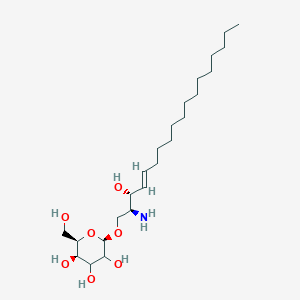PSYCHOSINE
PSYCHOSINE is a lipid of Sphingolipids (SP) class. Psychosine is associated with abnormalities such as Globoid cell leukodystrophy, Demyelinating Diseases, Multiple Sclerosis, nervous system disorder and Lysosomal Storage Diseases. The involved functions are known as Ionization, Pathogenesis, Demyelination, 5-(carboxyamino)imidazole ribonucleotide mutase activity and Increased Sensitivy. Psychosine often locates in Body tissue, CNS - Brain (MMHCC), Autosome, Peripheral Nervous System and Nerve Tissue. The associated genes with PSYCHOSINE are GALC gene, NTRK1 gene, JUN gene, ALPP gene and Polylysine. The related lipids are Fatty Acids, fatty aldehyde, lysophosphatidic acid, Stearic acid and stearoyl chloride. The related experimental models are Mouse Model and Streptozotocin Diabetes.
References related to functions published in J. Biol. Chem.
| PMID | Journal | Published Date | Author | Title |
|---|---|---|---|---|
| 8557709 | J. Biol. Chem. | 1996 | Sakakura C et al. | Plasmalopsychosine of human brain mimics the effect of nerve growth factor by activating its receptor kinase and mitogen-activated protein kinase in PC12 cells. Induction of neurite outgrowth and prevention of apoptosis. |
| 11294874 | J. Biol. Chem. | 2001 | Hikita T et al. | A novel plasmal conjugate to glycerol and psychosine ("glyceroplasmalopsychosine"): isolation and characterization from bovine brain white matter. |
| 15326175 | J. Biol. Chem. | 2004 | Wang JQ et al. | TDAG8 is a proton-sensing and psychosine-sensitive G-protein-coupled receptor. |
| 15485889 | J. Biol. Chem. | 2004 | Malone MH et al. | The glucocorticoid-induced gene tdag8 encodes a pro-apoptotic G protein-coupled receptor whose activation promotes glucocorticoid-induced apoptosis. |
